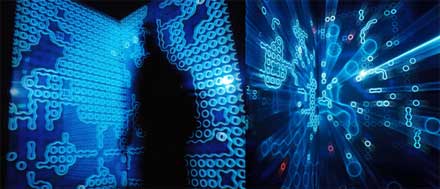Eden was inspired by Jon McCormack's time in the Litchfield National Park, in Australia. The artwork is a self-generating, artificial ecosystem complete with rocks, biomass and sonic animals populated. The creatures evolve, move about the environment, emit and listen to sounds, forage for food, encounter predators and mate with each other.

edena's creatures begin life with little knowledge. Over the years (1 eden year passes by in about 15 minutes of real time), they evolve, learning to adapt to their environment and more complex behaviours start to emerge. If a creature can mate before it dies, it passes on its genetic material to its offspring (eden uses Lamarckian evolution).
The creatures can recognise the tonal "colour" of the sound they hear and identify its direction. Through evolution, the creatures learn to make sounds and to hear the sounds of others. Sound is only made by a creature if it improves survival, to mate or find food for example. In other evolutions, they use sound to keep people within the physical space of the installation (sensors around the installation detect human movement.) Their movement and presence is mapped to the food supply for the creatures: if there are no people, the food supply dries up and the creatures starve to death.

Eden is part of a series of works that try to imagine what life would be like if it computer algorithms could replace the real nature lost in urban environments through human development and progress. Eden has been developed in 2000 but is still so fascinating and relevant that i chose it to illustrate McCormack's work rather than his most recent piece: Bloom.
Eden was part of Art.ficial Emotion, great review of the event in data is nature. Small video.
Other works that explore environment of artificial life: Technosphere by Jane Prophet, Life Spacies II by Christa Sommerer & Laurent Mignonneau.

